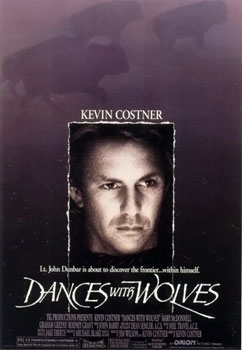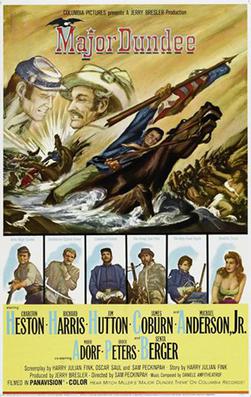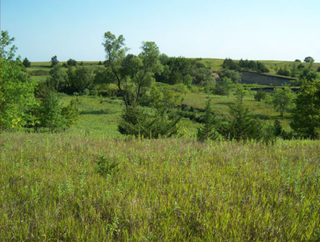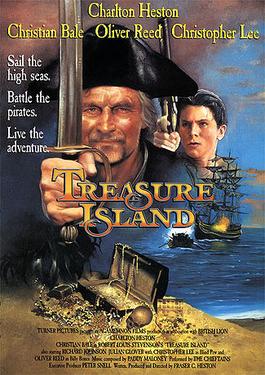
The Crow, whose autonym is Apsáalooke, also spelled Absaroka, are Native Americans living primarily in southern Montana. Today, the Crow people have a federally recognized tribe, the Crow Tribe of Montana, with an Indian reservation, the Crow Indian Reservation, located in the south-central part of the state.

The Battle of the Little Bighorn, known to the Lakota and other Plains Indians as the Battle of the Greasy Grass, and commonly referred to as Custer's Last Stand, was an armed engagement between combined forces of the Lakota Sioux, Northern Cheyenne, and Arapaho tribes and the 7th Cavalry Regiment of the United States Army. The battle, which resulted in the defeat of U.S. forces, was the most significant action of the Great Sioux War of 1876. It took place on June 25–26, 1876, along the Little Bighorn River in the Crow Indian Reservation in southeastern Montana Territory.

Dances with Wolves is a 1990 American epic Western film starring, directed, and produced by Kevin Costner in his feature directorial debut. It is a film adaptation of the 1988 novel Dances with Wolves, by Michael Blake, that tells the story of Union Army Lieutenant John J. Dunbar (Costner), who travels to the American frontier to find a military post, and who meets a group of Lakota.

Red Cloud's War was an armed conflict between an alliance of the Lakota, Northern Cheyenne, and Northern Arapaho peoples against the United States and the Crow Nation that took place in the Wyoming and Montana territories from 1866 to 1868. The war was fought over control of the western Powder River Country in present north-central Wyoming.

The Treaty of Fort Laramie is an agreement between the United States and the Oglala, Miniconjou, and Brulé bands of Lakota people, Yanktonai Dakota, and Arapaho Nation, following the failure of the first Fort Laramie treaty, signed in 1851.

The Battle of the Rosebud took place on June 17, 1876, in the Montana Territory between the United States Army and its Crow and Shoshoni allies against a force consisting mostly of Lakota Sioux and Northern Cheyenne Indians during the Great Sioux War of 1876. The Cheyenne called it the Battle Where the Girl Saved Her Brother because of an incident during the fight involving Buffalo Calf Road Woman. General George Crook's offensive was stymied by the Indians, led by Crazy Horse, and he awaited reinforcements before resuming the campaign in August.

The Battle of Fort Ridgely was an early battle in the Dakota War of 1862. As the closest U.S. military post to the Lower Sioux Agency, the lightly fortified Fort Ridgely quickly became both a destination for refugees and a target of Dakota warbands after the attack at the Lower Sioux Agency. It came under attack by the Dakota on August 20, 1862, two days after a company of soldiers responding from the fort to the attack on the Lower Sioux Agency had been ambushed and defeated at the Battle of Redwood Ferry. The Dakota besieged and partially destroyed the fort, but were unable to storm it before the August 27 arrival of Colonel Henry Sibley with 1400 men from Fort Snelling prompted them to retreat.

The Sioux Wars were a series of conflicts between the United States and various subgroups of the Sioux people which occurred in the later half of the 19th century. The earliest conflict came in 1854 when a fight broke out at Fort Laramie in Wyoming, when Sioux warriors killed 31 American soldiers in the Grattan Massacre, and the final came in 1890 during the Ghost Dance War.

Major Dundee is a 1965 American Western film directed by Sam Peckinpah and starring Charlton Heston, Richard Harris, Jim Hutton, and James Coburn. Written by Harry Julian Fink, the film is about a Union cavalry officer who leads a contentious troop of Army regulars, Confederate prisoners, and Indian scouts on an expedition into Mexico during the American Civil War to destroy a band of Apaches who have been raiding United States bases and settlements in the New Mexico territory. Major Dundee was filmed in various locations in Mexico. The movie was filmed in Eastman Color by Pathécolor, print by Technicolor.

Thunderheart is a 1992 American Neo-Western mystery film directed by Michael Apted from a screenplay by John Fusco. The film is a loosely based fictional portrayal of events relating to the Wounded Knee incident in 1973, when followers of the American Indian Movement seized the South Dakota town of Wounded Knee in protest against federal government policy regarding Native Americans. Incorporated in the plot is the character of Ray Levoi, played by actor Val Kilmer, as an FBI agent with Sioux heritage investigating a homicide on a Native American reservation. Sam Shepard, Graham Greene, Fred Ward and Sheila Tousey star in principal supporting roles. Also in 1992, Apted had previously directed a documentary surrounding a Native American activist episode involving the murder of FBI agents titled Incident at Oglala. The documentary depicts the indictment of activist Leonard Peltier during a 1975 shootout on the Pine Ridge Indian Reservation.

Spotted Tail was a Sichangu Lakota tribal chief. Famed as a great warrior since his youth, warring on Ute, Pawnee and Absaroke (“Crow”), and having taken a leading part in the Grattan Massacre, he led his warriors in the Colorado and Platte River uprising after the massacre performed by John M. Chivington's Colorado Volunteers of the peaceful Cheyenne and Arapaho camping on Sand Creek, but declined to participate in Red Cloud's War.

Big Eagle was the chief of a band of Mdewakanton Dakota in Minnesota. He played an important role as a military leader in the Dakota War of 1862. Big Eagle surrendered soon after the Battle of Wood Lake and was sentenced to death and imprisoned, but was pardoned by President Abraham Lincoln in 1864. Big Eagle's narrative, "A Sioux Story of the War" was first published in 1894, and is one of the most widely cited first-person accounts of the 1862 war in Minnesota from a Dakota point of view.
Wooden Leg was a Northern Cheyenne warrior who fought against Custer at the Battle of the Little Big Horn.

The Battle of Wood Lake occurred on September 23, 1862, and was the final battle in the Dakota War of 1862. The two-hour battle, which actually took place at nearby Lone Tree Lake, was a decisive victory for the U.S. forces led by Colonel Henry Hastings Sibley. With heavy casualties inflicted on the Dakota forces led by Chief Little Crow, the "hostile" Dakota warriors dispersed. Little Crow and 150 followers fled for the northern plains, while other Mdewakantons quietly joined the "friendly" Dakota camp started by the Sisseton and Wahpeton bands, which would soon become known as Camp Release.

The Battle of Birch Coulee occurred September 2–3, 1862 and resulted in the heaviest casualties suffered by U.S. forces during the Dakota War of 1862. The battle occurred after a group of Dakota warriors followed a U.S. burial expedition, including volunteer infantry, mounted guards and civilians, to an exposed plain where they were setting up camp. That night, 200 Dakota soldiers surrounded the camp and ambushed the Birch Coulee campsite in the early morning, commencing a siege that lasted for over 30 hours, until the arrival of reinforcements and artillery led by Colonel Henry Hastings Sibley.

Three Violent People is a 1957 American Western film directed by Rudolph Maté and starring Charlton Heston, Anne Baxter, Gilbert Roland, Tom Tryon, Forrest Tucker, Bruce Bennett, and Elaine Stritch.

Treasure Island is a 1990 British-American made-for-television film adaptation of Robert Louis Stevenson’s 1883 novel of the same name, written and directed by Fraser Clarke Heston, and also starring several notable British actors, including Christian Bale, Oliver Reed, Christopher Lee, Julian Glover and Pete Postlethwaite.

The Dakota War of 1862, also known as the Sioux Uprising, the Dakota Uprising, the Sioux Outbreak of 1862, the Dakota Conflict, or Little Crow's War, was an armed conflict between the United States and several eastern bands of Dakota collectively known as the Santee Sioux. It began on August 18, 1862, when the Dakota, who were facing starvation and displacement, attacked white settlements at the Lower Sioux Agency along the Minnesota River valley in southwest Minnesota. The war lasted for five weeks and resulted in the deaths of hundreds of settlers. In the aftermath, the Dakota people were exiled from their homelands, forcibly sent to reservations in the Dakotas and Nebraska, and the State of Minnesota confiscated and sold all their remaining land in the state. The war also ended with the largest mass execution in United States history with the hanging of 38 Dakota men.

Run of the Arrow is a 1957 American Western film written, directed, and produced by Samuel Fuller and starring Rod Steiger, Sara Montiel, Brian Keith, Ralph Meeker, Jay C. Flippen, and Charles Bronson. Set at the end of the American Civil War, the movie was filmed in Technicolor.

White Swan (c.1850—1904), or Mee-nah-tsee-us in the Crow language, was one of six Crow Scouts for George Armstrong Custer's 7th Cavalry Regiment during the 1876 campaign against the Sioux and Northern Cheyenne. At the Battle of the Little Bighorn in the Crow Indian Reservation, White Swan went with Major Reno's detachment, and fought alongside the soldiers at the south end of the village. Of the six Crow scouts at the Battle of the Little Bighorn, White Swan stands out because he aggressively sought combat with multiple Sioux and Cheyenne warriors, and he was the only Crow Scout to be wounded in action, suffering severe wounds to his hand/wrist and leg/foot. After being disabled by his wounds, he was taken to Reno's hill entrenchments by Half Yellow Face, the pipe-bearer (leader) of the Crow scouts, which no doubt saved his life.



















